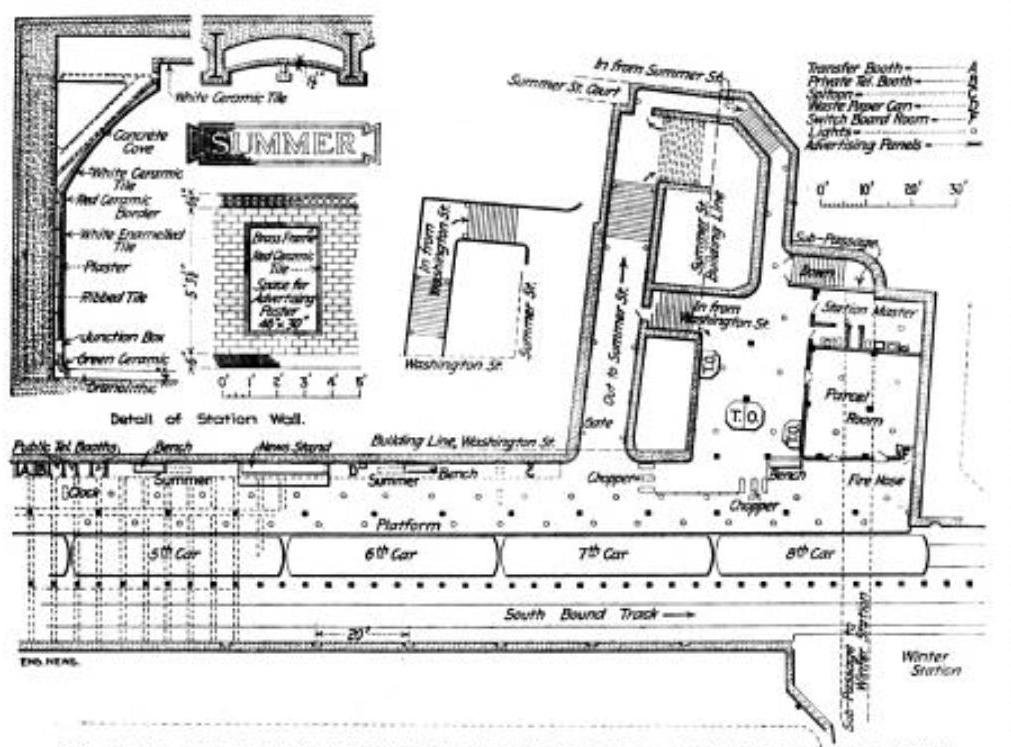
Downtown Crossing Station Boston: Visiting Hours, Tickets, and Travel Guide
Date: 15/06/2025
Introduction
Downtown Crossing Station is a vital transit hub at the heart of Boston’s historic commercial district. More than a subway stop, it serves as a gateway to the city’s architectural heritage, vibrant shopping areas, and cultural landmarks. Opened in 1915 as part of the Cambridge-Dorchester Line (now the Red Line), its strategic location beneath Washington, Winter, and Summer Streets connects visitors directly to Boston’s urban energy and storied past (SAH Archipedia; PPS).
This comprehensive guide provides detailed information on Downtown Crossing Station’s history, architecture, visitor amenities, accessibility, nearby attractions, and practical tips to optimize your Boston experience.
Table of Contents
- Introduction
- History and Urban Context
- Station Architecture and Design
- Role in Boston’s Transit System
- Visiting Hours and Ticketing
- Accessibility Features
- Tours, Events, and Nearby Attractions
- Urban Renewal and Modernization
- Frequently Asked Questions (FAQ)
- Boston Historical Sites: Old State House & Boston Common
- Summary and Key Points
- References
History and Urban Context
Early Development
Downtown Crossing Station, initially called Washington Street Station, played a key role in Boston’s transformation into a commercial and transportation hub. Located beneath Boston’s busiest commercial artery, Washington Street, the station was designed to serve the city’s dense retail district rather than the outlying suburbs (SAH Archipedia; PPS). Its location at the intersection with Winter and Summer Streets placed it near legendary department stores like Jordan Marsh and Filene’s.
Growth and Significance
The station’s development was part of Boston’s response to increasing urban congestion in the late 19th and early 20th centuries. The Boston Elevated Railway Company (BERy) pioneered rapid transit in the city, leading to the formation of the MBTA and the expansion of Boston’s subway system (MBTA History).
Station Architecture and Design
Downtown Crossing Station’s design reflects Boston’s tradition of integrating transit infrastructure with the urban landscape. Key features include:
- Discreet Entrances: Multiple street-level entrances, including at Washington & Summer Streets and Chauncey & Summer Streets, blend seamlessly into the busy retail environment (SAH Archipedia).
- Distinctive Interiors: Underground platforms feature colored tiles, standardized wayfinding, granite seating, and public art installations—such as Lewis “Buster” Simpson’s Situations.
- Surrounding Architecture: The area showcases Beaux Arts, Spanish Renaissance, and Classical Revival buildings, notably the landmarked Jewelers’ Building, constructed in 1897 and 1904 (Universal Hub).
Role in Boston’s Transit System
Downtown Crossing is a critical interchange between the MBTA’s Red and Orange Lines, ranking as Boston’s second busiest subway station with over 24,000 entries per weekday (Wikipedia). The station also connects to major bus routes, including the Silver Line SL5, and is central to the city’s transit maps and wayfinding infrastructure (MBTA History).
Visiting Hours and Ticketing
- Operating Hours: Approximately 5:00 AM to 1:00 AM daily. MBTA schedules may vary by line and day, so check the official MBTA schedule for updates.
- Ticketing: Purchase tickets at vending machines in the station, or use CharlieCard and CharlieTicket systems. Visitors can also buy unlimited-day passes, ideal for tourists (Metro Fandom).
Accessibility Features
Downtown Crossing Station is fully accessible:
- Elevators and Ramps: Available at all major entrances.
- Tactile Paving: Provides guidance for visually impaired travelers.
- Clear Signage: Updated wayfinding for easy navigation.
- Staff Assistance: Personnel available during operating hours (Metro Fandom).
Tours, Events, and Nearby Attractions
Guided and Self-Guided Tours
While the station does not offer official tours, its location is ideal for starting self-guided or GPSmyCity walking tours of Boston’s historic core (GPSmyCity).
Seasonal Events
Downtown Crossing’s pedestrian mall regularly hosts public events, street performances, and seasonal markets, creating a lively atmosphere for visitors (PPS).
Photographic Highlights
- Inside the Station: Historic tilework and art installations.
- Street Level: Bustling crosswalks, brick sidewalks, and surrounding landmark buildings.
Nearby Landmarks
- Old South Meeting House (Freedom Trail landmark)
- Boston Common
- Faneuil Hall Marketplace
- Quincy Market
- Jewelers’ Building
Urban Renewal and Modernization
Downtown Crossing has undergone significant upgrades, including the transformation of Washington Street into a pedestrian mall in the late 20th century (PPS). Recent renovations—such as a $29.7 million station overhaul completed in 2021—have improved cleanliness, signage, and overall visitor comfort (Wikipedia). Maintenance closures, such as Orange Line platform work in 2022, reflect ongoing investment in safety and service quality.
Preservation efforts, including the landmark status for buildings like the Jewelers’ Building, ensure the district’s character remains protected as Boston continues to modernize (Universal Hub).
Frequently Asked Questions (FAQ)
Q: What are Downtown Crossing Station’s operating hours?
A: Generally 5:00 AM to 1:00 AM daily. Check the MBTA schedule for real-time updates.
Q: How do I buy tickets?
A: Use vending machines at the station, or purchase and recharge CharlieCards/CharlieTickets. Visitor passes are also available.
Q: Is the station accessible?
A: Yes, with elevators, tactile paving, and staff assistance.
Q: Are there guided tours?
A: No official station tours, but numerous guided and self-guided tours of the surrounding district are available (GPSmyCity).
Q: What are the top nearby attractions?
A: Old South Meeting House, Boston Common, Faneuil Hall, Quincy Market, and the Jewelers’ Building.
Boston Historical Sites: Old State House & Boston Common
Old State House
Address: Intersection of Washington and State Streets
History: Built in 1713, the Old State House is Boston’s oldest public building and a key site from the American Revolution, including the reading of the Declaration of Independence and the Boston Massacre (Old State House official site).
Visiting Hours: Daily 9:00 AM–5:00 PM (last admission 4:30 PM; check for holiday hours).
Tickets: $15 adults, $10 seniors/students, free for children under 6. Purchase online or at the entrance.
Tours and Events: Guided tours and educational programs are offered; check the official events calendar.
Accessibility: Wheelchair accessible with ramps and elevators; audio guides and tactile exhibits available.
Photography: Permitted (no flash or tripods).
Nearby: Faneuil Hall, Boston Common, Freedom Trail.
For more, visit the Old State House official site.
Boston Common
Address: 139 Tremont Street, Boston, MA 02111
History: Established in 1634, Boston Common is the nation’s oldest public park and a central gathering site for historic events and recreation (Boston Common Official Page).
Hours: Open daily 6:00 AM–11:00 PM; free entry.
Guided Tours: Offered by Boston National Historical Park and local companies; self-guided options available via Audiala App.
Accessibility: Wheelchair accessible, paved paths, accessible restrooms.
Events: Summer concerts, winter skating at Frog Pond, public demonstrations.
Nearby: Boston Public Garden, Freedom Trail, Downtown Crossing.
Tips: Visit in spring or fall for optimal weather; use public transit for easy access.
For details, visit the Boston National Historical Park.
Summary of Key Points
Downtown Crossing Station remains a cornerstone of Boston’s urban landscape—blending historic architecture, modern transit, and vibrant city life. Its central location provides seamless access to top attractions like the Old South Meeting House, Jewelers’ Building, Boston Common, and the Freedom Trail (Universal Hub). The station’s design, accessibility, and modernization efforts ensure a comfortable and efficient experience for all visitors (SAH Archipedia; Metro Fandom). Although there are no official tours within the station, curated walking tours and nearby historic sites are easily accessible (GPSmyCity).
For real-time updates, ticketing, and travel tips, download the Audiala App and follow related social media channels.
References
- Downtown Crossing Station Wikipedia, 2025
- SAH Archipedia on Downtown Crossing Station, 2025
- Project for Public Spaces on Downtown Crossing, 2025
- Universal Hub, Jewelers’ Building Landmark News, 2025
- MBTA History and Accessibility Overview, 2025
- Metro Fandom on Downtown Crossing Accessibility, 2025
- GPSmyCity Guided Walking Tours, 2025
- Audiala App for Boston Transit and Tours, 2025
- Old State House official site
- Boston Common Official Page
- Boston National Historical Park

































































































































